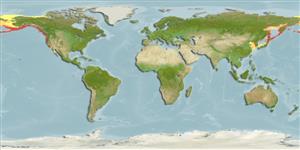Common names from other countries
>
Perciformes/Zoarcoidei (Eelpouts and pricklebacks) >
Anarhichadidae (Wolffishes)
Etymology: Anarrhichthys: Greek, anarhichaomai = to climb up + Greek, ichthys = fish; ocellatus: ocellatus for the eye-like spots..
More on author: Ayres.
Environment: milieu / climate zone / depth range / distribution range
Écologie
marin démersal; profondeur 1 - 226 m (Ref. 2850). Temperate; 80°N - 26°N, 117°E - 111°W (Ref. 57366)
North Pacific: Sea of Okhotsk and the Sea of Japan to the Krenitzen Islands, in the Aleutian chain and Imperial Beach, southern California, USA.
Taille / Poids / Âge
Maturity: Lm ? range ? - ? cm
Max length : 240 cm TL mâle / non sexé; (Ref. 4925); poids max. publié: 18.4 kg (Ref. 27436)
Description synthétique
Clés d'identification | Morphologie | Morphométrie
Épines anales: 0; Rayons mous anaux: 200. Dorsal with 228-250 spines. Caudal small. Anal with up to 233 rays.
Adults seek shelter among rocks in subtidal areas (Ref. 2850) and will occupy the same shelter until driven out by larger wolf-eels or a large octopus (Ref. 28499). Juveniles are pelagic for up to two years (Ref. 28499). Feed on hard-shelled invertebrates and fishes (Ref. 2850). Both male and female wrap their body around the egg mass to keep the eggs in place and to deter predators (Ref. 58332). Large specimens can inflict a painful bite (Ref. 28499). Its flesh is tasty (Ref. 28499).
When courting, the male wolf-eel butts his head against the female's abdomen, wraps around her, and fertilizes her eggs as she extrudes them. Eggs are laid and both male and female wrap themselves around the egg mass to protect it . Only one parent at a time leaves the eggs to feed. The female periodically rotates the eggs until they hatch. A male and female may pair for life (Ref. 28499).
Eschmeyer, W.N., E.S. Herald and H. Hammann, 1983. A field guide to Pacific coast fishes of North America. Boston (MA, USA): Houghton Mifflin Company. xii+336 p. (Ref. 2850)
Statut dans la liste rouge de l'IUCN (Ref. 130435)
CITES (Ref. 128078)
Not Evaluated
Menace pour l'homme
Traumatogenic (Ref. 2850)
Utilisations par l'homme
Pêcheries: intérêt commercial mineur; Aquarium: Aquariums publics
Outils
Articles particuliers
Télécharger en XML
Sources Internet
Estimates based on models
Preferred temperature (Ref.
115969): 1.2 - 10.5, mean 4.7 (based on 485 cells).
Phylogenetic diversity index (Ref.
82804): PD
50 = 1.0312 [Uniqueness, from 0.5 = low to 2.0 = high].
Bayesian length-weight: a=0.00398 (0.00174 - 0.00913), b=3.17 (2.97 - 3.37), in cm Total Length, based on LWR estimates for this (Sub)family-body shape (Ref.
93245).
Niveau trophique (Ref.
69278): 3.5 ±0.53 se; based on food items.
Résilience (Ref.
120179): Faible, temps minimum de doublement de population : 4,5 à 14 années (tm=7; Fec=10,000).
Fishing Vulnerability (Ref.
59153): Very high vulnerability (90 of 100).
